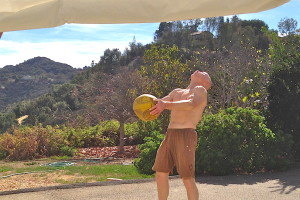Tips On Contrast Training for Better Performance
Happy Wednesday!
I hope your week has been productive so far.
I’ve been very busy coaching my clients, having business meetings, lifting stones, eating good food, painting gifts, doing tai-chi, enjoying my Health Mate IR sauna, watching some “Arrow”, and sleeping well.

My mother, Meera Censor, just sent me this photo of two new castings of her bust of Father Gregory Boyle, made from her original clay sculpture. He doesn’t have his new glasses on yet.
Father Gregory Boyle did A LOT to help the gangs of LA and other areas in the US, and has the most successful program to date to help these families.
He started Homeboy Industries to provide a variety of jobs for gang members and ex-convicts. His Catholicism is what I’d call practical and worldly.
It gave me great joy to hear his life story, and brought up many deep emotions and tears. His the story is quite riveting and inspiriing, particularly when you realize its true!
My mother has sculpted over 20 very special people who devoted their lives to helping humanity. You can see and read about many of them on her web site (www.humanitariansculpture.com), or in her lovely little book, Humanitarians for Justice, Nonviolence and Peace: Journey of an Unexpected Sculptor (Sep 3, 2011).
Tips On Contrast Training for Better Performance

Contrast training is a method for improving how much work volume you can perform per set, and can also be used to get more reps at higher intensities than usual.
Today in my vlog, I explain the logic behind contrast training, and demonstrate how to do it.
In essence, contrast training is a term that describes coupling two lifts that are either the same, or similar in movement pattern, while on load is typically quite intense (1-6 Rep Max range), coupled with a significantly less intense load/lift.
Going from a big lift immediately to a similar lift at less intensity allows you to both keep working when you’d normally be resting, and, to train at two significantly different speeds of movement.
Extending sets to gain total work volume is very useful for athletes that have high demands for both strength, and endurance in their sport.
Rugby and wrestling are examples of such sports. They are also examples of sports that require functional strength in a wide varieties of speeds; speed training is quite specific.
You can go from heavy to light to extend a set and gain speed after a heavy slow lift. You can go from a lighter load to a heavier load to work endurance, and then tap out your fast twitch fibers, and again, both will offer differing speeds of movement.
This provides a neurologically and physiologically rich training environment.
Though the principle is typically used in the conditioning of athletes, it can be applied effectively with almost anyone, even in pure rehabilitation situations.
Like any complex principle (addressing multiple factors), this kind of training must be implemented intelligently. If not, it’s likely to be death by Wise-guy!
I hope you enjoy my little video lesson in contrast training today.
And, “NO”, I don’t use any form of anabolic steroids; anyone with knowledge on the topic would look at me and know in an instant I am not a user of these highly dangerous performance drugs.
That said, you’d be amazed at how many people think that way, and leave some amazingly silly comments to demonstrate the affects nutritional deficiency in action…
Can you imagine being a school teacher today?!
Suggested Resources:
1. Scientific Core Conditioning – correspondence course or elearning
2. Advanced Program Design – correspondence course or elearning
3. How To Eat Move & Be Healthy! (see exercise library)
4. Strong-N-Stable DVD set.
Today at 12pm PT, I’ll be delivering my, A Holistic Approach to Nutrition, Lifestyle, Fitness, and Spiritual Growth at the Future of Nutrition Conference! The best part, the conference is FREE. This is a great opportunity to hear my views and avail yourself of many other industry experts.
Love and chi,
Paul Chek
















Find me on the web